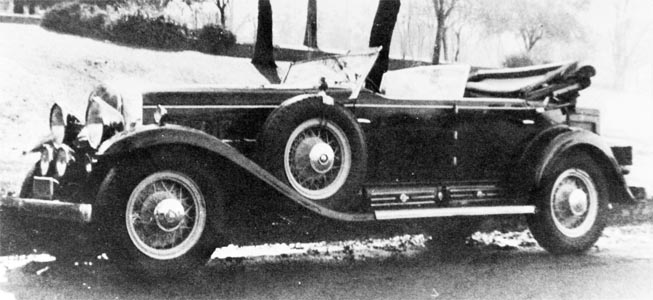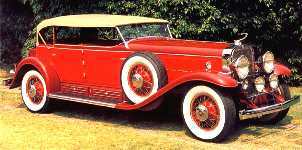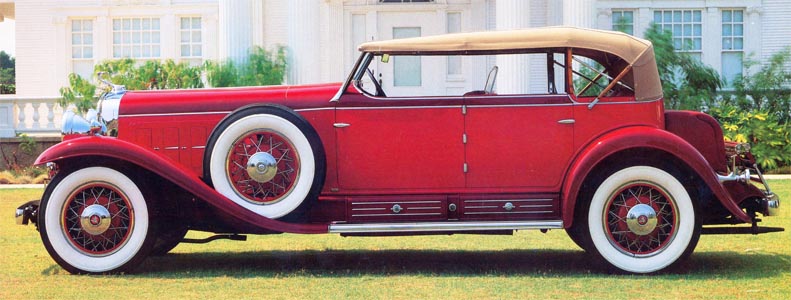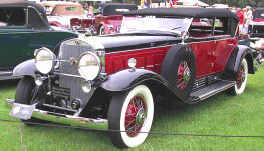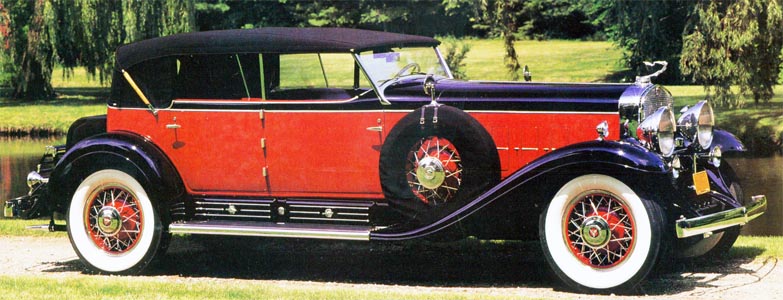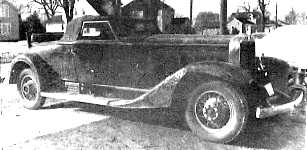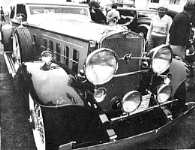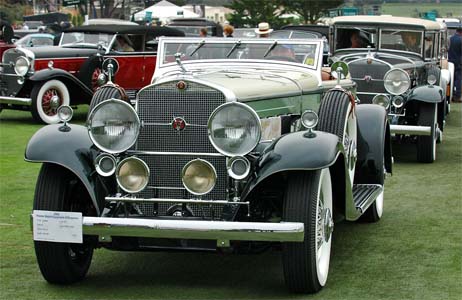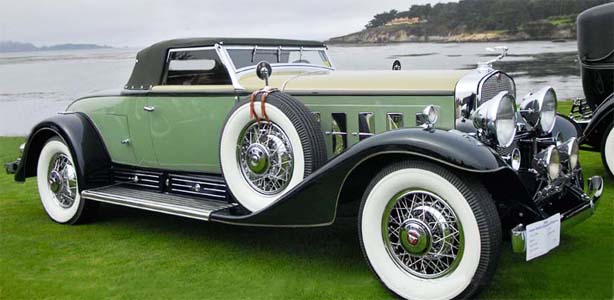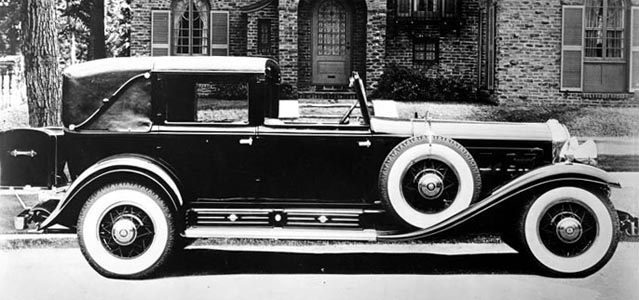Body
Style |
Body Number |
Engine
Number |
Latest available information |
Town
Brougham |
? |
? |
Bronckhorst
(or Bronkhorst) [Netherlands])
Special V-16 7-passenger Ľ-window brougham with canework on lower rear
quarters [like Fleetwood style #4264-B but a longer body, with quarter
windows added, full-sized jump seats folding into partition]. I am
wondering if this might not be a conversion from the 1930 V-16 Town Brougham
tour car, Fleetwood style #4264-B? These views are from the 30's
French trade magazine, Auto-Carrosserie No. 92, Figs. 16-18. The car
is mentioned also in an earlier salon report for the same magazine [maybe
No. 91] of which I do not have a copy. The images below are Xerox
copies, hence the relatively poor quality. The car is not believed to have
survived. |
|
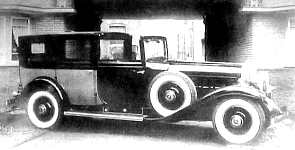
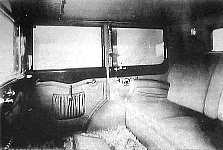 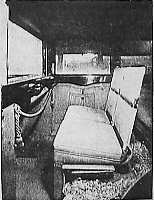
This could be the European tour car
style 4264B with a modified
rear body (addition of quarter windows and full width jump seats)
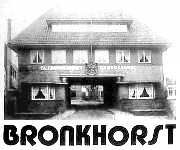
The premises of the Dutch coachbuilding
firm
|
Town Car |
? |
? |
By Kellner [Alexis of
Germany or Georges of Paris]; in any case it is not believed to have
survived. |
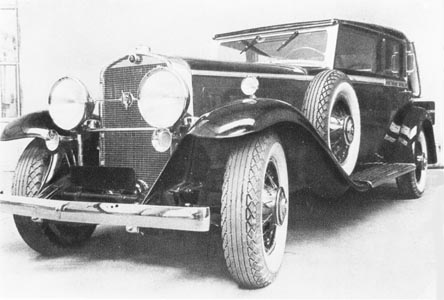
|
Boattail
Speedster |
? |
Between
703136
and
703152 |
Farina [Italy] Factory
records [which I have not seen] reveal that the chassis of this car left
Detroit on July 17, 1931, bound for Turin, Italy [that month, only 17 cars/chassis
were completed, they were #703136 to 703152].
The special, boat-tailed speedster or "tiger-shoot" car was commissioned by
the wealthy Maharajah of Orccha, one of India's princely states before the
country gained independence in 1947. The Self Starter issue for
June, 1965, carried a factory photo of the car, the same one that I got from
the PF archives in 1975 and that I wrote about in the Classic Car magazine
for June 1976. Dave Towell, Cadillac dealer and collector of Akron, OH,
wrote me in September 1976 to say that he had bought the car in April that
year, from the late Sheikh Mukhtar, a Pakistani actor and film director who
had acquired it in 1960, directly form the Maharajah, for a reported 7000
rupees (circa $560). In 1976, the car had barely 12K miles on the
odometer. The car's presence in the USA sparked much interest; Bill
Mitchell, then Director of GM Styling, went to Akron to examine it. Gita and
I went to see Dave's cars too, in June 1978, on our first trip to the USA.
Grand memories! I understand that Dave paid $105,000 for the car. It
arrived in Akron in July 1976. He did almost no restoration work on the car
before selling it again. The car was later acquired by Tom Barrett,
then by Jack Frederick and Fran Roxas who, in my opinion, "over-restored" it.
The roadster was featured shortly thereafter in AQ, Vol.
20, #4, in its new black garb with an unlikely red velour interior (!). In
the eighties, Ken Behring acquired it for his renowned Blackhawk collection
in Danville, CA. This particular ad appeared in the CLC's
Self-Starter
magazine in August, 1983: 1930 V16 Boat-tail "The ultimate
50s hot rod". The car was being offered for sale by a Mr. Jack
Wenger of Broadway, VA (I assume it was this same car). Motor Trend
ran an article on the car, in March 1985. According to the Self Starter
for July, 2001, the current owner is Robert Lee of Sparks, NV.
Rare and "exotic" Cadillacs like this one have a habit of turning up in the
most unexpected places and at the oddest times; their tale is often told,
distorted, embellished, often for the sole purpose of increasing the car's
marketability. Late Extra
(5/2010): I'm not sure if there is
any truth to a rumor that the car is to be repainted back to black with red
trim [the repaint colors selected by Jack Frederick and Fran Roxas in the 80s] for upcoming show (in 2010?) of Pinin Farina
custom jobs. It sounds odd indeed (and very expensive).
Will the car be repainted, again, back to the original PF color scheme,
after that show? Note: Members of
a classic car forum in India have discussed this car; they seriously doubt
the accuracy of information about it on internet sites (including mine?) and
in magazines like Motor Trend. According to the current Maharaja of
Orccha, HH Madhugar Shah, whose father ordered this car, it remained in use
with the Orccha family at least until the late fifties and would drop him
off and pick him up from school. He asserted that it was never designed, nor
used, for hunting tigers; that was just a myth! One of the original
"V-16" hubcaps still survives in the Orccha garages. According to one member
of the forum, the Pinin Farina speedster and a rare Duesenberg SSJ with body
Gurney-Nutting that had belonged to India's princely Holkar family, were
smuggled abroad by actor Sheik Mukhtar and traded for a pair of new 1960
Chevy Impalas! Another members, Nigel Davis with whom I have been in
contact, remembers seeing the car in the late sixties when it was still
owned by film actor and director Sheik Mukhtar. It's licence tag read "ORCCHA
1"; he said it was parked on the road; Mukhtar had come to visit a famous
Indian story-writer. Nigel was a little boy at that time but he still
remembers the car. Years later he read in
Motor Trend how Mukhtar had found the car buried in the ground with
the boat tail sticking out. He bought it and later took it out of the
country, though Pakistan, and sold.Will the truth ever be known? |
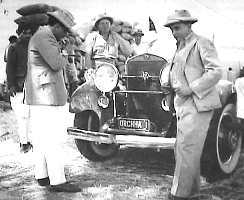
The pith-helmeted, mustachioed gentleman lighting a
smoke on the left is the
wealthy Maharajah of Orccha; his car carries the tag "ORCCHA 1"
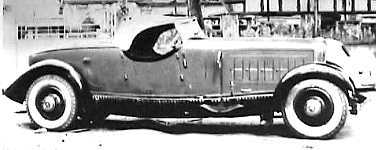
The car is seen here, in India, in the early sixties,
with sidemounts removed
and the skimpy weather canopy in place; it is fitted with very British,
flick-up turn signal indicators [just ahead of the upper front door hinge]
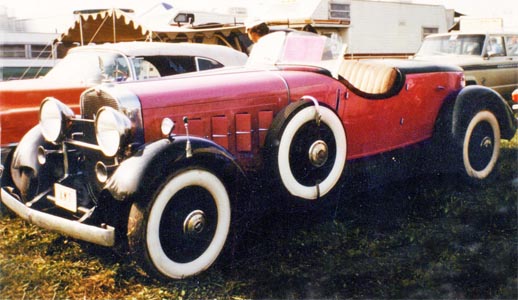
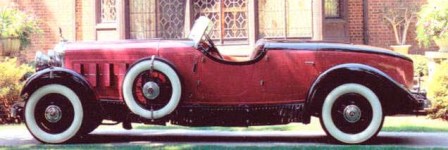 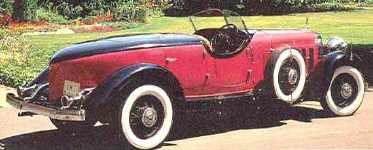
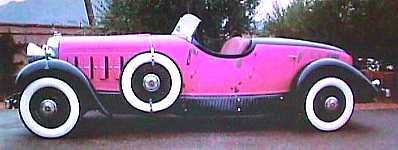
Sheikh Mukhtar painted the car this fuchsia hue
[above 2 rows, in different lighting];
it was still like this when Dave Towell brought it to the USA and later sold it to
Tom Barrett III
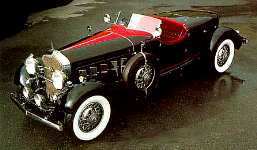
[ Click on image for larger view ]
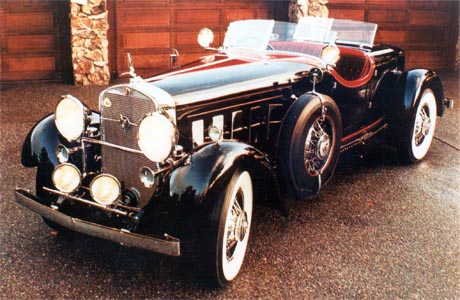
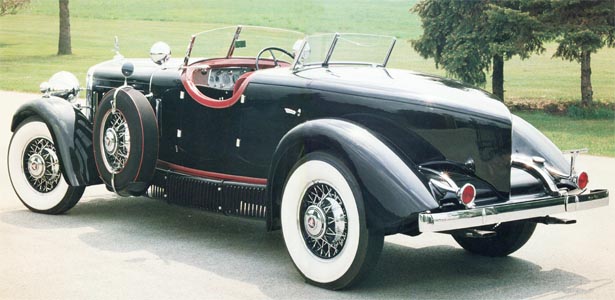
Photo (right): courtesy Automobile Quarterly
 
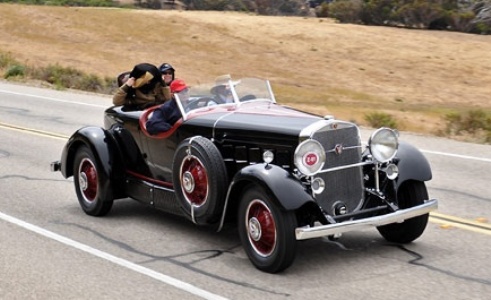 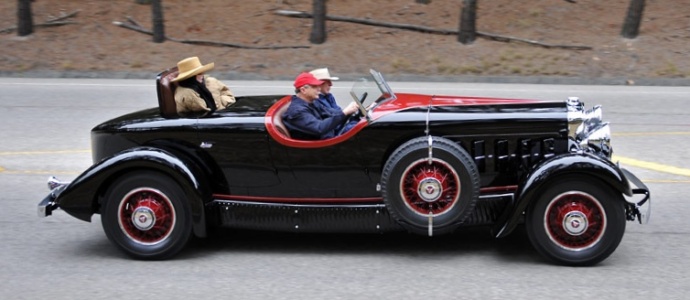
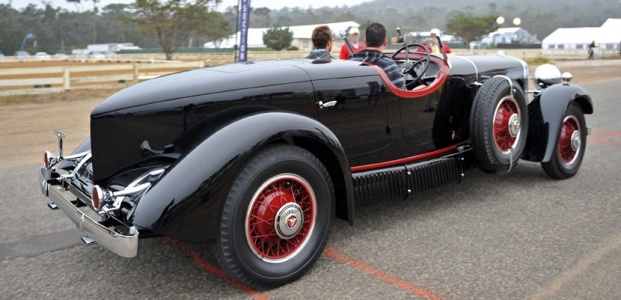 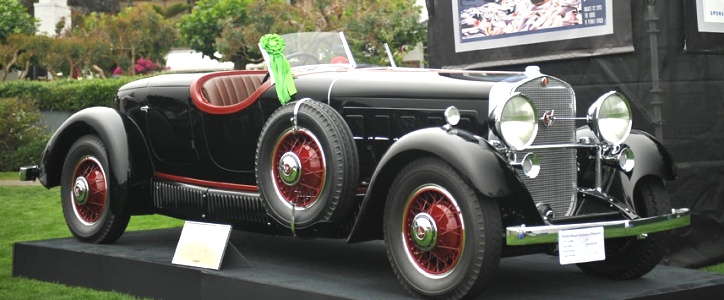
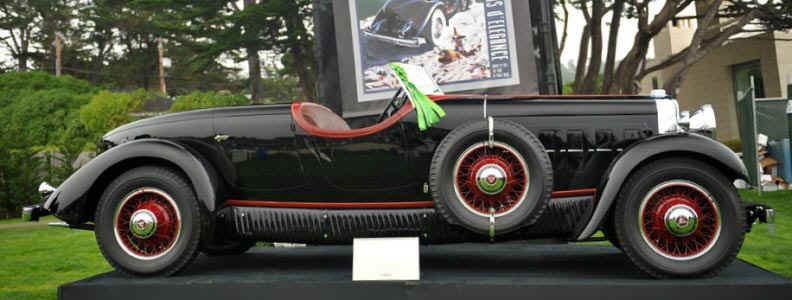 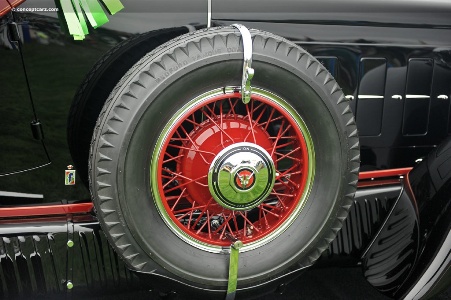
Photos in above 4 rows: © ConceptCarz.com

The original Farina colors are not known but from
this factory photo
you can see that they were not those chosen by Fran Roxas, who restored it;
the later repaint (pale blue and cream) probably are closer to reality
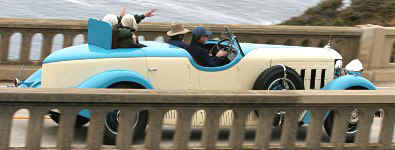 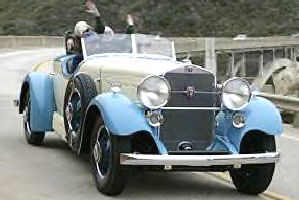 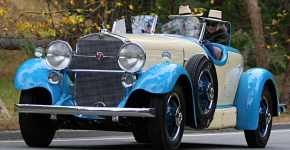
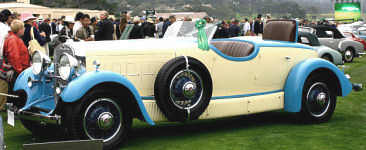 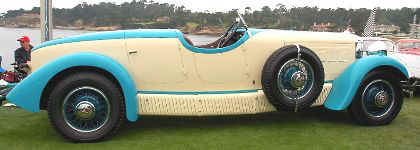
In these two rows: This is how the car looked at
Pebble Beach, in 2005; it appears to have been repainted closer to the Farina original,
above;
in addition, the scarlet velour seat material [installed by Fran Roxas?]
appears to have been replaced by more plausible, dark brown leather
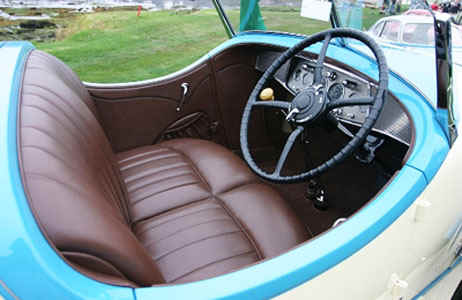
|
Convertible
Victoria? |
? |
702873 |
Lancefield [England] According
to Matt Larson of the CLC, this engine/chassis combination had RHD and was exported to
England in 1930. I initially thought it had got a saloon [sedan] body designed by
Van den Plas and possibly built by Lancefield in England. This former "mystery
V16" was offered for sale by auction by the Kruse organization in 1996 (lot
#696). It was described as a V16 convertible (?) of 1930 [actually 1931, from the
VIN] with RHD and body by Lancefield of England. The colors were given as cream and green.
The upper photo, below is from the collection of Gregg D. Merksamer of the Society
of Automotive Historians (SAH); others are from the internet. Late extra (Oct., 2010): The car was brought to my
attention again by owner-enthusiast and V-16 "sleuth", Chris Cummings. Chris said: This car was bodied by Lancefield in England. It
is reputed to have been among a small group of bare chassis shipped to Van Den Plas, from
where it made its way to the UK. Manny Dragone purchased it in Europe about ten years ago,
sold it to a buyer in Connecticut, and recently took it back in trade for another car. Mr.
Dragone did some paint and upholstery work some years ago, and some work had been done on
the car before he bought it. He says that the seller told him the car had been exhibited
at the London Motor Show in 1931 . I have read a few reports of the 1931
London Motor Show at Olympia, in specialized UK magazines of the period; there was no
mention of this custom job; the only such job mentioned was a limousine-landaulet with
body by Van den Plas (described below)]. Chris pointed me to the web page of the Manny
Dragone classic car collection in Bridgeport, CT, where the car resides. It is said to be
an excellent older restoration and is fitted with a high speed rear axle. The car is for sale for $650,000! BTW, I have seen a drawing
of a V-16 by Lancefield, but the latter is not a convertible. |
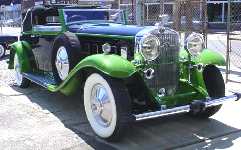 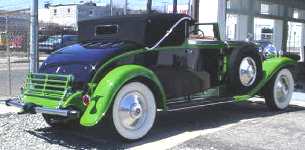
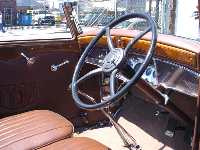 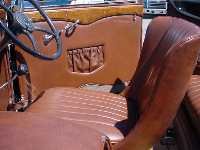
This custom job features a straight sill with
overlapping
body work, and a horizontal belt molding
[ Photos, above 2 rows: Internet, June, 2004 ]

Until recently, the car had these
special wheel discs (over wire wheels?)
[ Photos, above row: Internet, October, 2010 ]
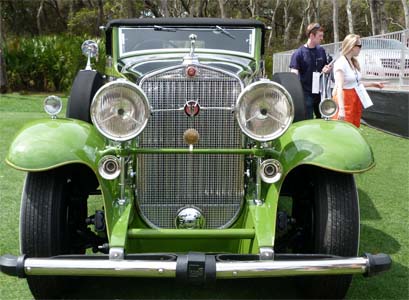

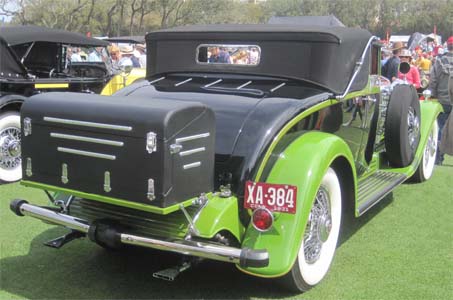
Amelia Island Concours d'Elégance,
March 2012; now the car sports chrome wire wheels
[ Photos, above 2 rows: © 2012, Gita Saunders ]
|
Town car |
? |
702073 |
Nordberg [Sweden] town car on 1930 chassis #702042.
This car was ordered by Torsten Krüger (the Swedish industrialist), son of Ernst Krüger,
the "Safety Match King" and younger brother of Ivar Krüger whose unethical
business practices ended with his suicide (or was it murder???) in Paris, in 1932. Torsten
helped run the family match business. In 1933, he was sentenced to a year in jail for a
so-called "economical swindle" (no details available). Krüger owned many
classic cars including a Bentley and a Duesenberg. He even owned his own island
(Bullerö) in the Swedish archipelago. There, he would entertain celebrities like Mary Pickford, Errol Flynn and Charlie Chaplin, taking them for cruises aboard his luxury motor
yacht, M/V United Spirit, a legendary Swedish luxury yacht that he built in 1934.
The Nordberg town landaulet was then acquired by Swedish media mogul, Vetus
Pettersson, in Malmö. The third and current (2010) owner is Helge Kaarinen, owner of Sparreholm Castle and car museum; he currently (2010) lives in London. This car is in its
original state and has never been restored. The coach-builder, Nordberg,
passed on in 1977; he had built many interesting custom bodies on Cadillac chassis,
including a number of them for the Swedish Royal family under the reign of King Gustaf V.
Correction for
October, 2011 (submitted by V16 "guru"
and friend, Chris Cummings): Chris says that this Norberb custom is
not the Kruger car, as I mentioned in error,
above. This Norberg creation (below) was built on spec by the Ostermans car
dealership in Stockholm. Chris wrote: The car sat in the showrooms (the
“Marble Halls”) for several years before Pettersson wandered in, not very
impressively dressed. The salesmen tried to give him the bum’s rush, but he
homed in on the V-16 town car and bought it off the showroom floor.
Chris added that the Kruger car was a Fleetwood style 4375 owned by
Anders Wald’s friend, Tage Jingnert.
As to the car pictures formerly included in this entry
[and that I have now moved
to the correct page] they showed a car
with painted metal sidemount covers; Chris identified it correctly as a
Fleetwood Series 4155) that lives in the Haynes Museum in Somerset, England. |
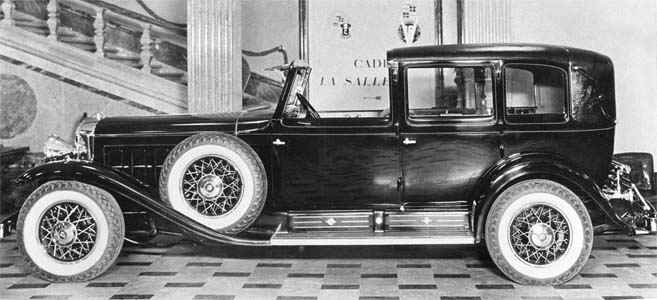
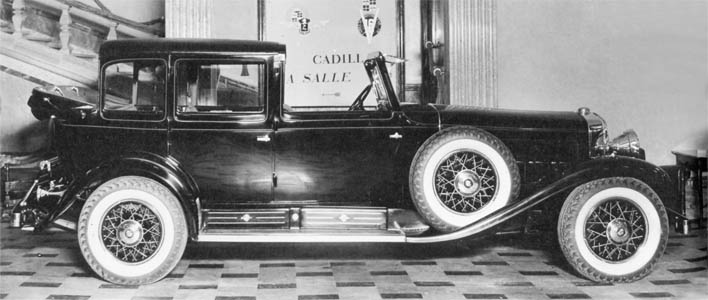
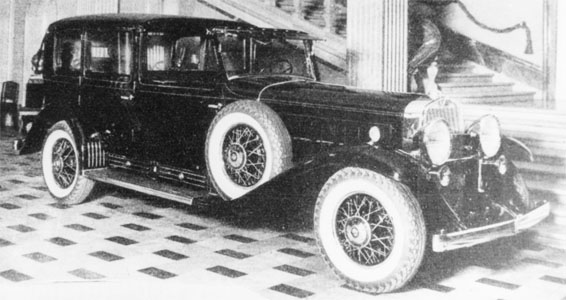 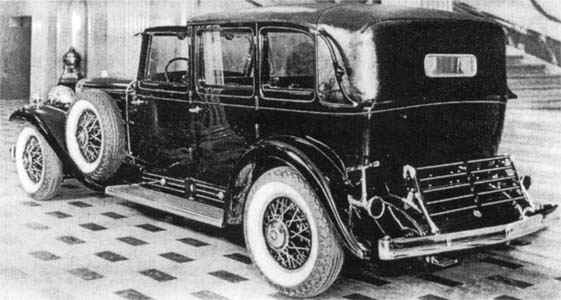
On display in the Nordberg showroom, 1930 (?)
[ Photos: courtesy Olle Ljungstrom and Fred Summers ]
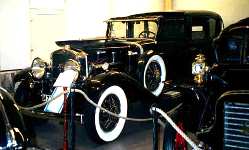 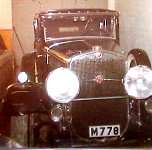 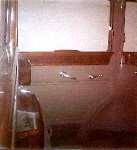
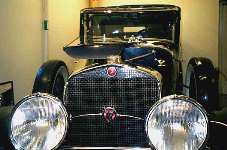
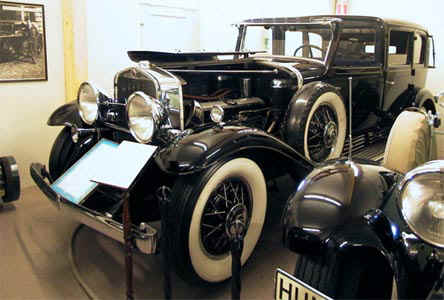 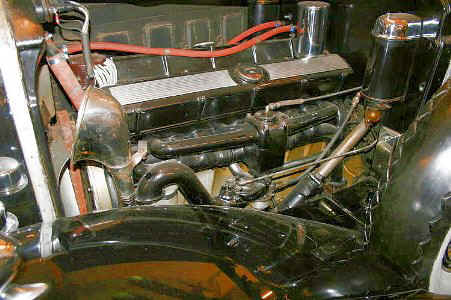
|
Part
Convertible Sedan
[ex-4260] |
n/a |
701554
then
700979
|
Saoutchik [France]
Chassis # 7-101(?), formerly
body #2 of the 85 units built, this was one of the six European tour cars
(the original sport phaeton body was put later on another V16 chassis). This
sport phaeton was Fisher order #2587; it was shipped to Copenhagen, Denmark on June
11, 1930 for the European promotional tour. Upholstery was Radel Spanish
grain leather #2400, trim style 19 (or 1930?); the entire hood, cowl and
body panels were painted in R&M Indiana gray (Duco #20157), as were the
wheel hubs, spokes and felloes. The molding and the hood and cowl vents
all were painted Saxon gray (Duco? #2445519); fenders and chassis were
painted Ravenwood brown (Duco #5782). The finish moldings on top of the belt
were chrome-plated. Wire wheels (six) were mounted, including two in the
fenders; the original tires had black side walls. A travel trunk was
mounted in the rear. Paris' Jacques Saoutchik later mounted a sedan body on
this engine/chassis combination; it had a special sliding roof with a transparent
roof that panel lined up with the rear window when the roof was fully retracted
[note that during the time that car remained in France, it carried French
tags "8651RK2"; when it was sold at an RM
auction in May, 2011, it had the same license tags!?!?]. The car is
believed to have been owned in 1960 by an elderly lady (89 years old at the
time); it was to have been sold at auction by a Paris garage, but an agent
of the owner turned up in the nick of time to pay an outstanding repair
bill. The subsequent sequence of events in this car's life is unclear; one
former owner is
said to have been the Marquis of Goulaine, who reortedly sold it later to a nephew of
the Count of Paris. It is said to have been also for some time in the possession of French auto dealer, Johnny Thuysbaert
who stored it his
château, near Nantes. Major repairs are assumed to have been carried out in
1964 by the Francis workshops near Paris; the story is related
in France's weekly Auto-Journal for August 6, 1964; there are
some photos. The car was then
apparently acquired by the late Serge Pozzoli, former editor of France's
Fanatique de l'Automobile, who stored it in a warehouse at Av.
Jean-Jaurčs, in Paris, near the "Poker" beer warehouse owned by
Hubert Le Gallais. Hubert subsequently bought it from Pozzoli and showed it
at various meets in and around Paris in the late sixties and early
seventies. I visited him in the early seventies and photographed the car at
his restaurant-home in Le Pavé du Roi near Fontainebleau; at that
time the car was dark blue with a dark brown roof. Later, Le Gallais moved to
Brittany (NW France) where he opened another restaurant. I lost track of the
V-16 in the late seventies and discovered, later, that it had returned to
the USA (in the mid-to-late-eighties or even early nineties): there it was
completely restored to the highest standards by respected restorer Fran Roxas of Alsip, Illinois for Fred Weber of St. Louis, Missouri. During
restoration, the Saoutchik body was removed from the Cadillac chassis on
which it was originally built [VIN 701554]. Roxas then put the Saoutchik body onto chassis
VIN 700979, another correct V-16 chassis that had received originally a Fleetwood
four-door sedan body; interestingly the latter chassis was originally ordered new by C.F. “Boss”
Kettering, the creator of the self starter, Delco, and a leading GM engineer
who went on to develop the Parade of Progress, that chassis in itself,
therefore, is of
historical importance. During
restoration, the original Marchal headlights mounted by Saoutchik were replaced with Grebels, I
guess to match the accessory, cowl spotlights (personally, I preferred the
huge Marchals). A new top was made and the hood ports were chrome-plated; a
central fog-light was added and the car got new paint.
After the restoration was completed, it was
purchased by Detroit-area real estate developer Bernie Glieberman
of West Bloomfield, MI; it garnered
noteworthy results. Major awards included a Class Award at Pebble
Beach in 1991 and at Meadow Brook in 1995 where it won Best in Class and the
Engineering in Excellence Trophy. It made a noted appearance at the
"Cadillac-La Salle Experience" meet at the Gilmore Museum, Hickory
Corner, MI, in June 1993. The car was shown again at Meadowbrook, in 1995.
It was later reported to be for sale at the annual Barrett-Jackson auction
in Scottsdale, AZ [year???]; it is said to have been bid to $325,000; the
program mentioned "Lot #9, color silver/blue, rare Saoutchik body with
retractable 2-position sunroof that rolls back to an open roof over the
passenger compartment. Lights by "Stephen Grabel" [typical BJ mis-spelling of
Stéphane Grebel]. Show quality restoration. Pebble-Beach winner. Asking
price $325,000" ...I imagine that Mr. Le Gallais had probably sold it
for less than $50,000! Late Extra
[1/2001]: The last-but-one owner acquired the automobile in
January 2001. This outstanding V-16 has won awards at the Pebble Beach
Concours, with yet another Class Award, and Amelia Island, where it received
the trophy for Most Elegant Closed Car, as well as at Palos Verdes and
Newport Beach. Recently in the care of noted restorers Alan Taylor and
Mosier Restorations, the car benefited from both a cosmetic upgrading and a
mechanical freshening in order to prepare the car for touring as well as
show purposes. The owner spoke to George Kovarda, who has a number of photos
of this car prior to and during the initial stages of restoration in the
USA. He does not believe Kovarda was working for Fran Roxas at the time he
had the car. Also, he only had the body there for the purpose of making it
back into a convertible sedan for Fred Weber. After Fred hired Marc Ohm to
run his "in house" restorations, they took the body back from George; they
decided not to make it a convertible after all, but to put the sliding roof
top back on the car. The new owner thinks that Saoutchik may have built the
car initially as a convertible sedan and someone else may have built the
sliding sunroof later; I doubt it; there was a tag on the top with the name of a firm in
Paris; my best guess is that Saoutchik did in fact design the special top but had
it installed by a specialist in the French capital].
Later [8/2007]:
the car found a new home during the Gooding & Co auction at Pebble Beach
on August 18, 2007, where it achieved a record price of $462,000 [thanks,
Chris Cummings, for this update].
Later still
[3/2011]: Chris advised that the car was being offered at
auction, in May 2011, during the prestigious Villa d'Este venue on lake
Como. We shall hear more about it soon. Even
later [4/2011]: My
daughter, Kelly, attended the show with her fiancé; she didn’t quite get her
photos right! Latest [5/2011]: Gita and I were honored to be
able to attend the Amelia Island Concours, where this car (among many others) was sold
once again. |
 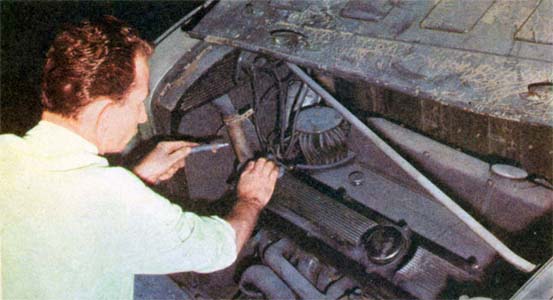
The Saoutchik car in Paris' Francis workshops, circa
1964
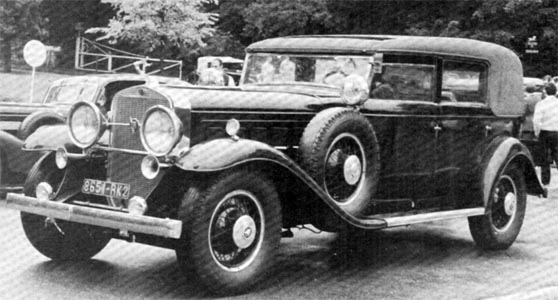 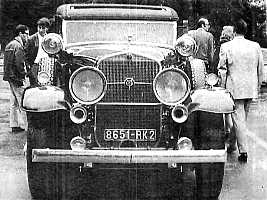 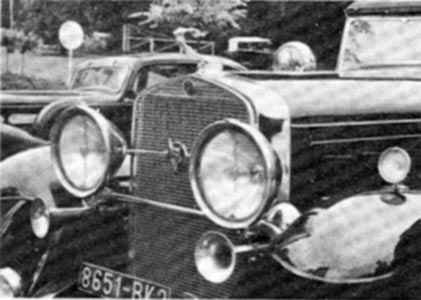
These French license plates were issued in Paris
(Seine region) between 10 March and 1 April, 1936; the restored car is on
show, here, near Paris. in the seventies
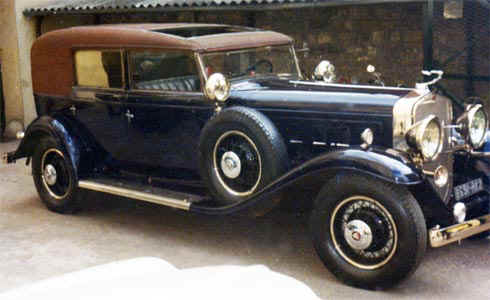

I photographed her at the Pavé du Roi, in
Fontainebleau, France, circa 1973-74 (left)

This text for the restored car (above, right)
asserts "...rare Grebel lights";
in fact, Saoutchik had fitted the car with Marchal headlamps and Grebel
spotlights;
during restoration the Marchals were traded for a pair of matching Grebels
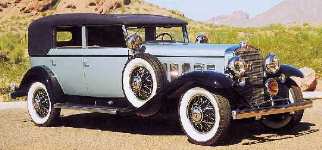 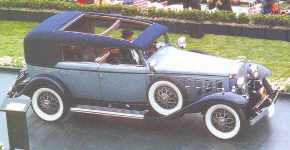
(top photo and left) As restored and offered for sale by auction in Scottsdale, AZ,
2000
(center and right) Pebble Beach concours d'Elégance, August 2002
[ in the latter 2 views you can see the sliding roof portion pulled back ]
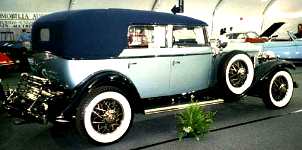 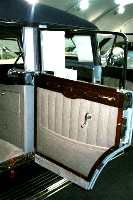
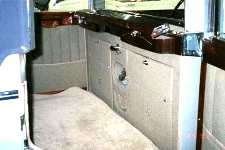 
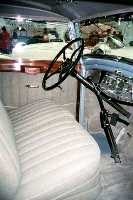
Preceding five photos courtesy of Elliott
Dolin, the new owner, 2001
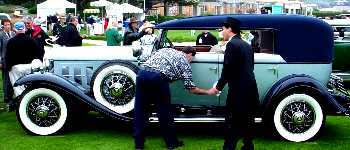 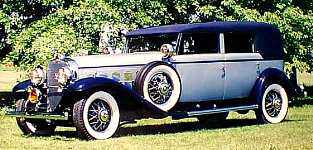
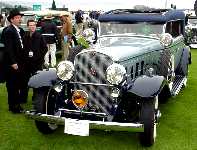 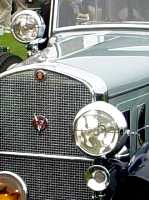  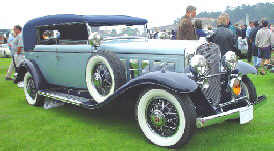
Digital photos don't like tight-woven grilles (center image);
note grille detail at right with Grebel headlights in lieu of the original Marchal lamps
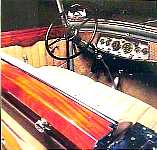  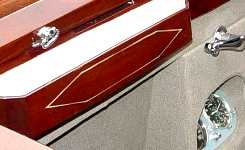
Beautiful cabinetry in this French custom creation;
note division winder and duplicate instruments in rear (right)
[ Pebble Beach photos in this set, courtesy "Jim", Aug. 2002 ]
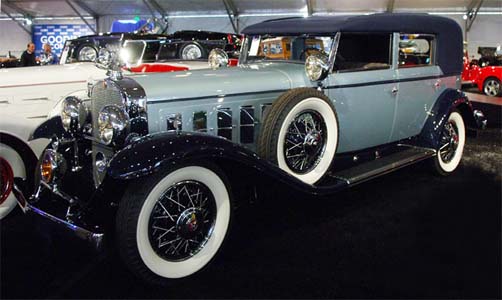
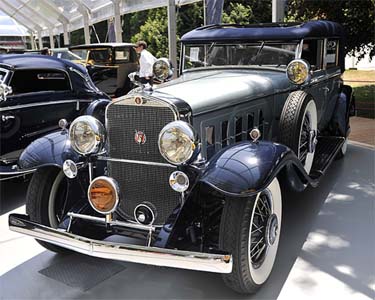
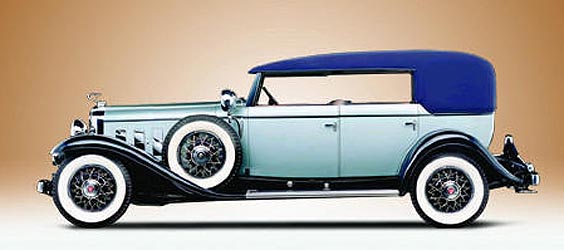
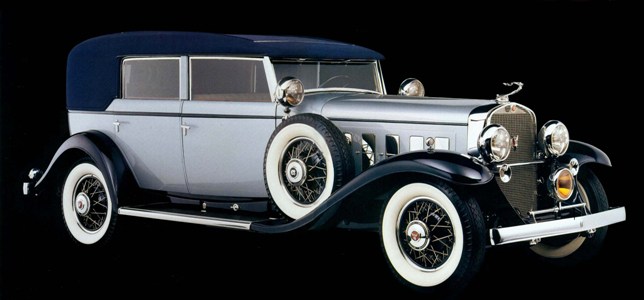
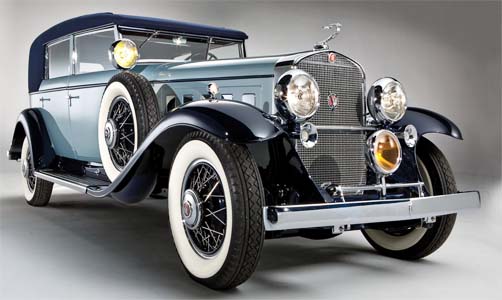
Whoever restored the car in
the USA replaced the original Marchal headlights with Grebels, to match the
accessory, cowl spotlights;
in addition to new paint and top, the hood ports were chrome-plated and a central
fog-light added
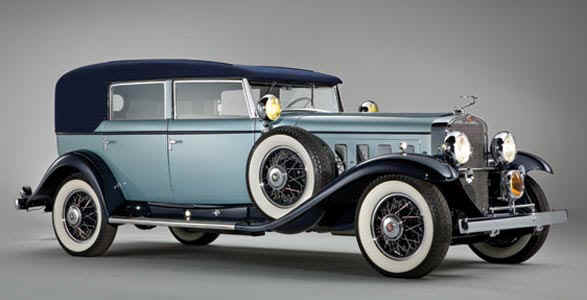 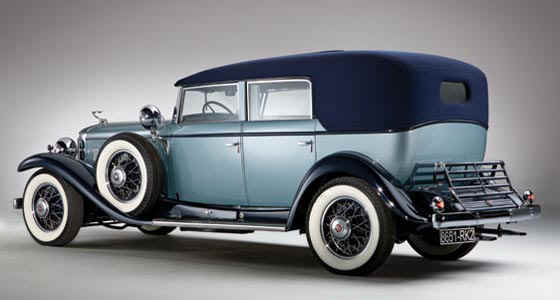
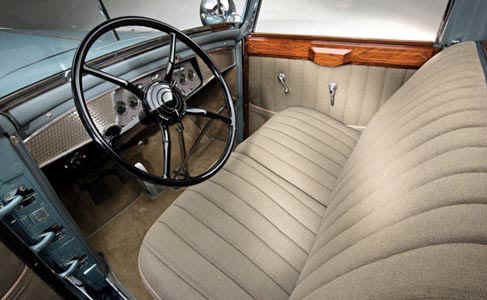
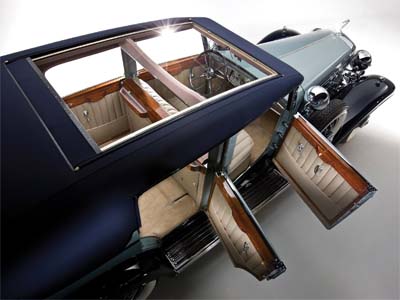
Surprising as it may seem the restored car,
offered for sale at auction by RM in 2011,
carries the same French license plates as were issued, in Paris, in 1936
[ Photos: © and courtesy RM auctions ]
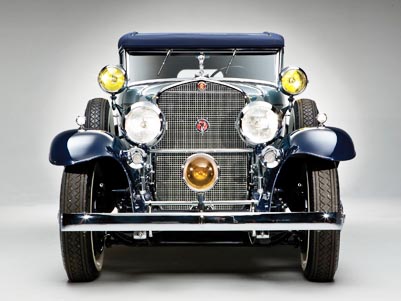
|
Limousine
Landaulet |
[556] |
702297 |
Van den
Plas [England and Belgium] This one
(and the one below it) left the factory
on July 9, 1930, bound for London and the
Olympia Motor Show. It is the same car I saw advertised in the Self Starter in
July, 1959, by a Mr. Jeffrey Watts of Levittown, PA. His ad reads: "1930-31
Cadillac V16 with English built body; originally owned by Guinness of stout fame; designed
by Van den Plas and built by [Lancefield for Van den Plas?] Lendrum and Hartmann, Ltd. RHD, compartmented [i.e.
limousine division?], folding landau back, English headlights (large), upholstery moth
eaten but beautiful, paint rough, mechanically looks excellent ($300 ...or may be
less)". So
far as I know, the car was offered for sale at a "Movieland - Cars of the
Stars" auction in Hollywood, in May 1974; Roy Schneider told me it was in a
deplorable state and did not find a buyer; it needed "everything" including a
highly talented enthusiast with some heavy funding. In his list of survivors, Rick Leforge
attributes this one to "Lyon Classic Cars, L.A." It appears it was
acquired at some time by the late "Cadillac Jim" Pearson of Kansas City; he
still had it in 1976. He subsequently sold it to James.C. Leake, a well-known
collector and dealer from Tulsa, OK. This car and the one below has RHD [one of the rare few built
this way!] and lots of wood inlays. Mr. Leake said of the car in 1977: "It
has the greatest amount of inlaid walnut wood throughout the car that I have ever seen and
there is also much brass." It was still undergoing a full restoration when I saw
it and photographed it from every angle in Tulsa in June, 1978. In the late
seventies the odometer reading was 56K miles (Note that in the most recent
advertisement for the car - in Apr. 2014 - the mileage is stated to be
54,693). This car is listed also among the
Database "Dream
cars" for 1930. Van den Plas described it as a
special Cadillac "Saloon Landaulette De Luxe" mounted on the V16
chassis. Initially, it was painted powder blue with black roof and fenders; styling
features include slender vertical windshield posts, flick up turn-signal indicators, a
flat windshield,
This car has the rare, split instrument panel of the "Madame X"
cars built in Fleetwood, PA (e.g. style #4108C)
[ERROR] opening rear roof section behind the rear seat
passengers, a rear seat
speedometer [ŕ la Fleetwood style 4260], an intercom, a rear foot-warmer, doors reaching down to partly cover the frame rails and "suicide"
rear doors; the descriptive text in the Van den Plas catalog states: "As supplied
to The Hon. A.E. Guinness" (head of the Guinness family of beer fame). It
was first shown at London's Earl's Court in 1930 together with a regular Fleetwood "Madame
X" style 4175; it may have gone on to the Paris Salon after that. Late Extra: I re-discovered the Van den Plas
town car in a Dutch museum, when Gita and I were vacationing in Holland, in
September 2001. Even later (Jan. 2013): The car was offered for sale by Bonhams of London and Paris.
Latest (Apr. 2014): The car has again
turned for sale at auction, this time from Lucky Collector Car Auctions
of Tacoma (WA) during their Spring Classic. Their catalog description pretty
well follows mine from 1978, including the mistake I made as to the
instrument panel configuration; in fact the car features the regular
instrument panel used on most Sixteens even before production was moved from
Fleetwood (PA) to Detroit (MI) in the spring of 1930. Re.:
"Hon.
Arthur Ernest Guinness: Sir Arthur Ernest GUINNESS, was a wealthy Irish brewer
whose beer still carries the family name. He was born on Nov, 2, 1876 and died in 1949. In 1903, he married Marie
Clotilde Russell, granddaughter of Lord Arthur Lennox. The couple had three daughters,
Aileen Sibell, Maureen Constance and Oonagh, known collectively as the Golden (Guinness)
Girls, with enviable social positions and, of course, lots of money. It was Mr. Guinness
who commissioned Lendrum & Hartmann, the London Cadillac dealer, to supply
him with a custom
landaulet on Cadillac V-16 chassis.
Trivia:
This car came up for in the classifieds of the British Motor magazine dated
April 4, 1934. It was described as a: Limousine Landolet
[sic], 1930 Cad,
double enclosed Vanden Plas, leather, forward occasionals, Ł295, Alpe and Saunders, Providence
Court, North Audley St (opposite Selfridges). Note that in the issue of the British monthly magazine, Motor, for October 16,
1935, on p.176, there is an ad for a special Barker Cabriolet Body, dark blue in color,
mounted on a Cadillac V8 chassis [no year indicated]. It was being offered for sale, for Ł200, by (again) none other than the Hon. A E Guinness, 17, Grosvenor
Pl. London SW1. |
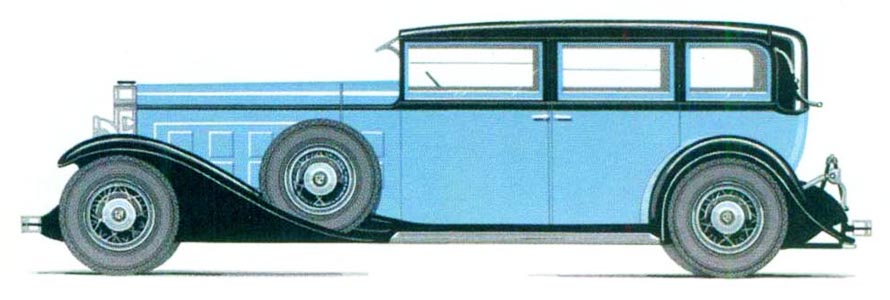
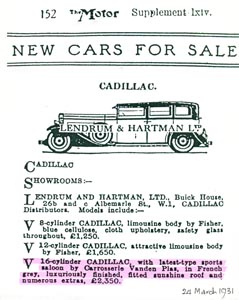

The artist's drawing (top) is from an original, 1930 Van den Plas
catalog; that image (in B&W) was used again in
supplement lxiv to Britain's Motor magazine (March 24,
1931? , to advertise this car (?) in the classifieds

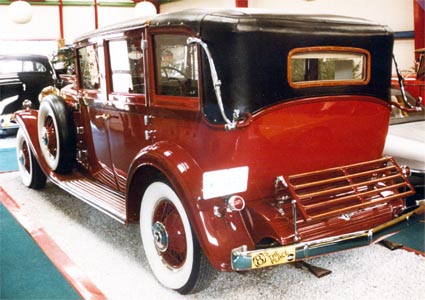
[ Photos: courtesy the late Gene Babow ]


Somehow, the restored car found its way to Holland
[ Photos: © 2001, Yann Saunders ]
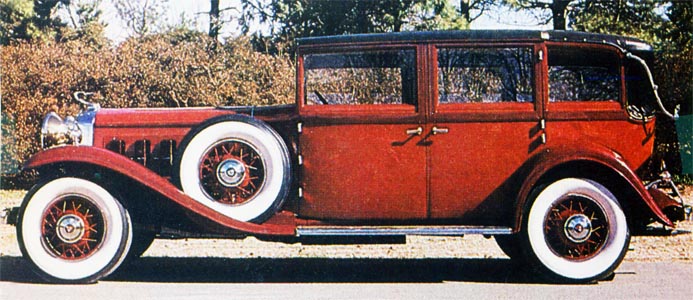
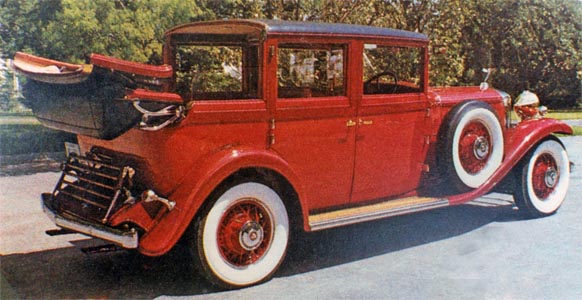
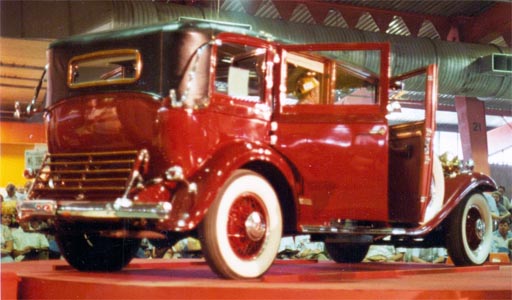
At one time or another the car was seen at
auction (as here); unfortunately, I don't have the date(s) or venue(s) at
this writing
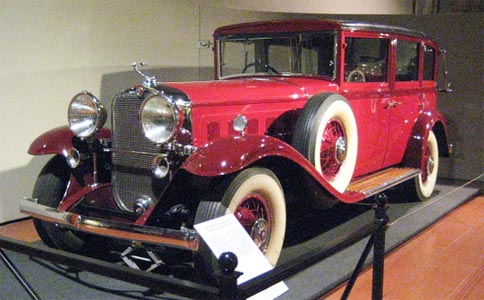
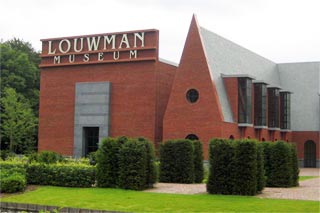
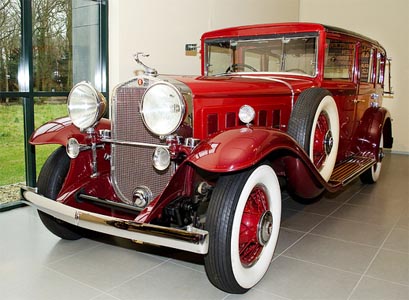
In a museum in Holland
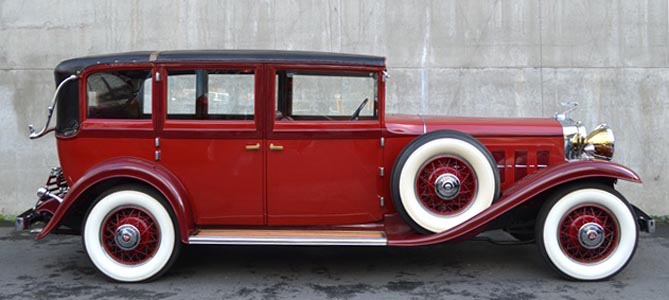
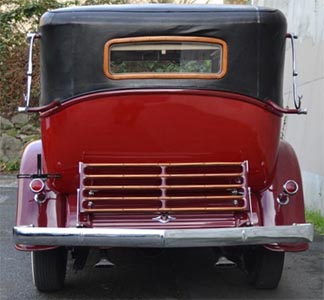
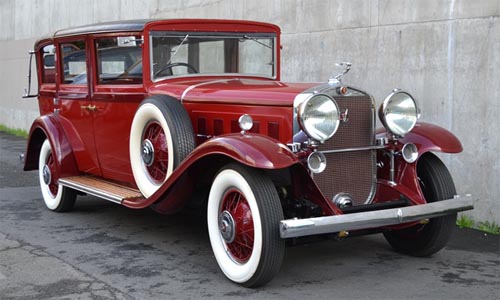
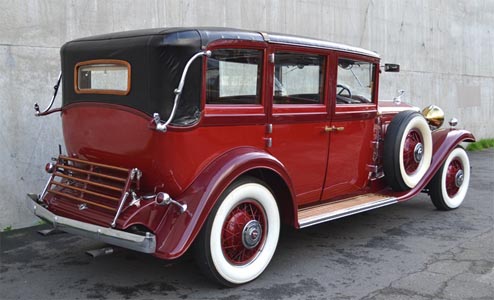
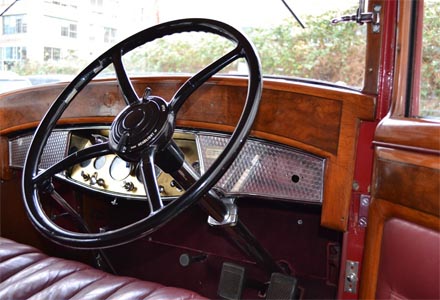
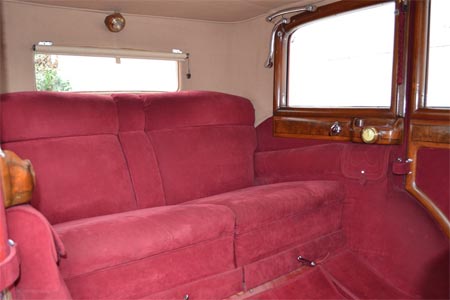
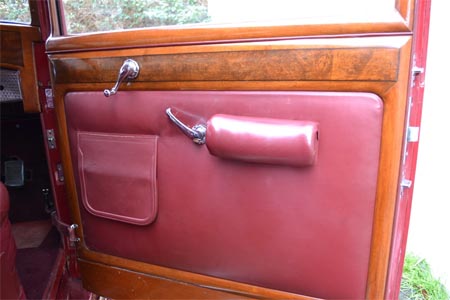
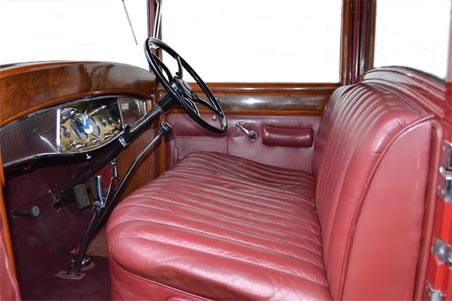
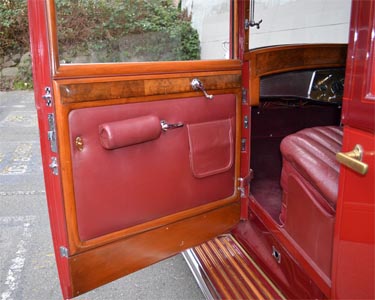
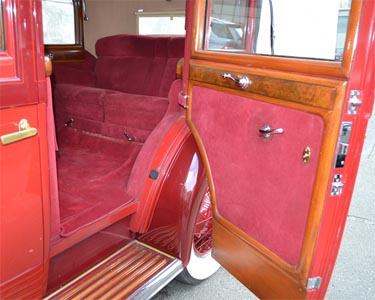
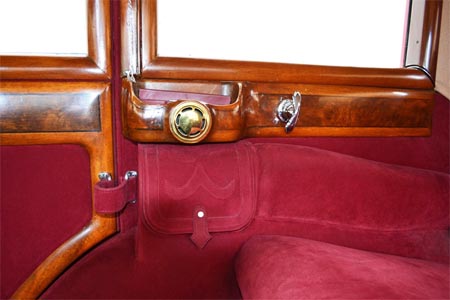
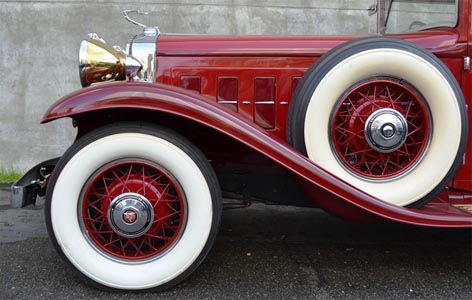
[Photos in above 7 rows: Lucky
auction catalog]
|
Limousine
Landaulet |
??? |
702298 |
Van den Plas [Belgium] again possibly built by Lancefield, in England, for Lendrum
& Hartman, the London Cadillac dealer. It left the factory in July of 1930
and is presumed to have been exported to London, as was also the other Van
den Plas creation, above. I got a telephone call in
June, 2004, from the grandson of this car's first owner, a wealthy Pakistani gentleman;
this car survives in Pakistan and we shall certainly be hearing more about it. Lancefield built a
similar car on the V12 chassis, designated a "special Cadillac Town Cabriolet De
Luxe" (a 5-pass. town car with forward facing opera seats). It is fitted with
cycle fenders and retractable (?) steps in lieu of running boards. Both doors are hinged
at the center post ("B" pillar). Originally light-colored, the body is now black
or dark blue; the original headlights have gone (perhaps replaced with
Grebel models). The coach type sill on the car is similar to that used on Fleetwood sixteens
with style codes in the "42.." series. Six wire wheels (with side-mounted
spares) are fitted (both tires appear to have been missing for some time). In the advertising brochure I saw in Washington, the text for the V12
version reads as follows: "This body is fitted with de Ville extension
[removable curtain over the driving area] but it is otherwise designed as a Town
Cabriolet with Fixed Head. (...) No running boards are fitted, steps being made to open
with the doors. A distinguishing feature is the special type of wings fitted [cycle
fenders]. Seating accommodation - The back seat is designed for two but can accommodate
a third and two occasional seats are fitted, facing forward. The driving seat is very
roomy and is designed specially for the comfort of the owner-driver. Colour scheme
optional, and a choice of the very finest cloths and soft leathers. As supplied to Captain
F.W. Hartman and Major E. Howard" [Captain Hartman was CEO of Lendrum &
Hartman, the long-standing Cadillac-LaSalle sales outlet in London's fashionable Albermarle
street, at
numbers 26B and C; he entered many of his personal Cadillacs in concours d'Elégance, at home and abroad, where he won many premier
awards. Service and maintenance of the Cadillacs and LaSalles was ensured at Old Oak Lane, in Willesden]. Among the classifieds in England's Motor
magazine for March 24, 1931, is an ad for this sports saloon painted French
grey and fitted with a sunshine roof. The advertised cost was Ł2350. The "full frontal" photo below was provided kindly by
V-16 enthusiast, Nigel Davis, who is familiar with the old car scene in India and
Pakistan. This rare survivor turned up at an auction in Bahawalpur, Pakistan, a former
Indian princely state during the British rule over the Indian sub-continent, which lapsed
at midnight on August 14, 1947. Bahawalpur acceded to the Dominion of Pakistan on October
7, 1947 and was merged into the state of West Pakistan on October 14, 1955 (the Nawab
[ruler] at the time is said to be of Arabic origin, claiming descent from Abbas,
progenitor of the Abassi Caliphs of Baghdad and Cairo). Like most rulers of the former
princely states, the last Nawab, Sir Sadiq Muhammad Khan Abbasi V, had untold wealth which
enabled him to acquire many superb automobiles. Twenty-six of these were released
and sold at auction in 2004, after being locked up for decades owing to some family
litigation (some have already found their way west). The
auction held in Bahawalpur, on May 9, 2004, generated over ten million Rupees (circa
$250,000) in revenue. Included among the lots were fourteen Rolls Royce models and two
Cadillacs. It is believed that the Cadillac, below, could NOT be sold as it was still
subject to a lien of some kind. Note how the "V-16" emblem on this car is
mounted squarely on the radiator stone guard, rather than on the usual stanchion between
the headlights. I would like to year back from the Pakistani gentleman who bought this car
to my attention in 2004. The second RH drive V-16 that actually sold is believed to by the
Van den Plas tourer listed above. I await confirmation. |
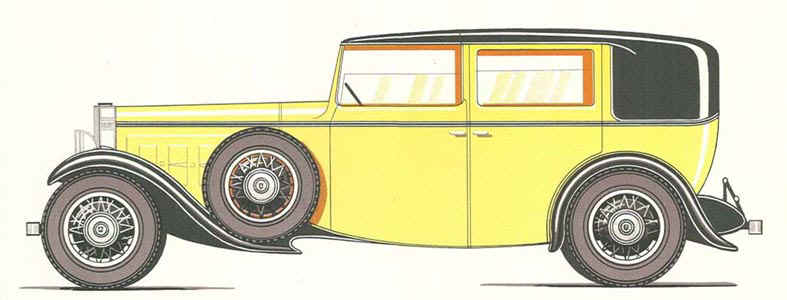
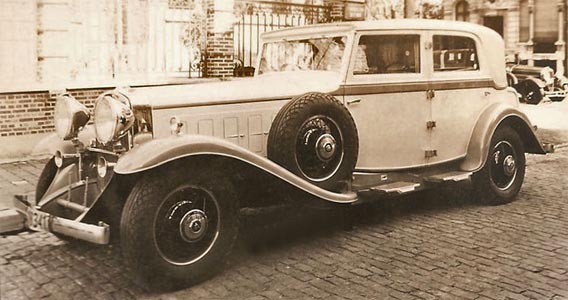
(Left) The Lancefield car, with cycle
fenders, hidden step plates and center-closing doors
(Right) a similar sport sedan by Van den Plas on the V16 chassis,
with center-hinged doors
and RHD; in the latter car the step plates are visible, even with the doors closed;
in my
opinion, the car on the right is largely derived from the designer's drawing on the left
[ B&W Photo: Sixteen Cylinder Motor
Cars, by Roy Schneider ]


Perhaps it was this image (and the blown-up
text) that was used in
supplement lxiv to
the classifieds in Britain's Motor magazine (March 24,
1931?)
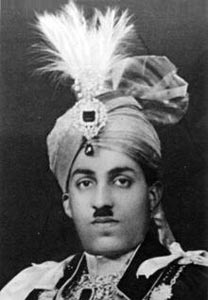
The Lucky Nabab in his heday!
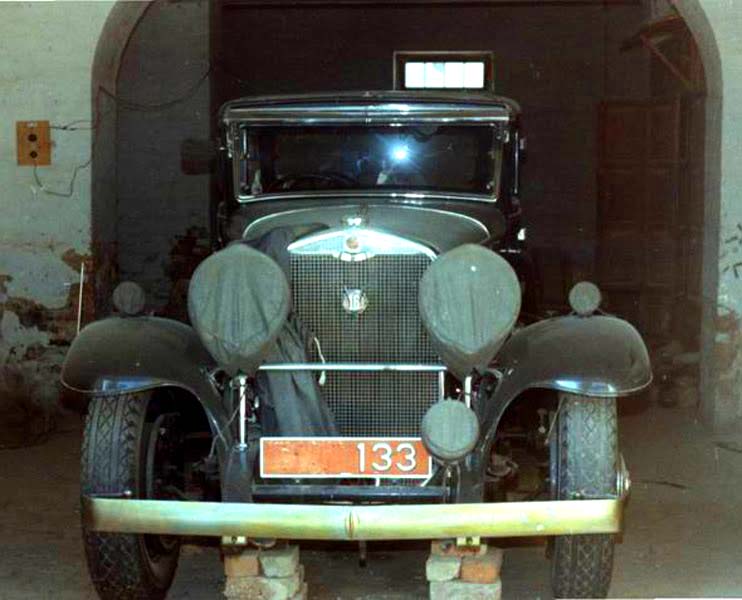
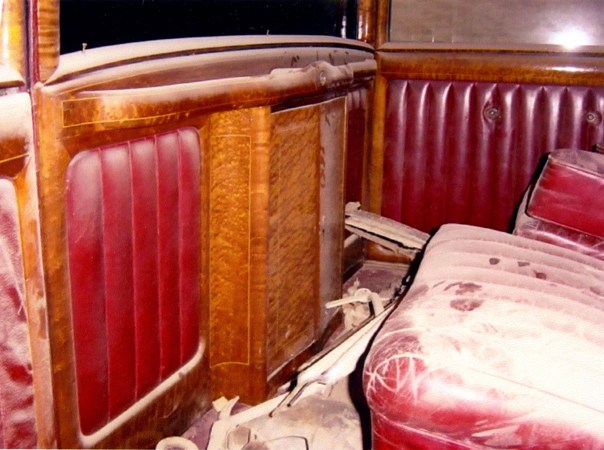

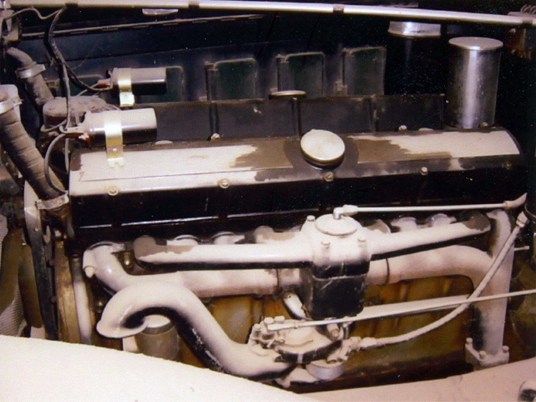

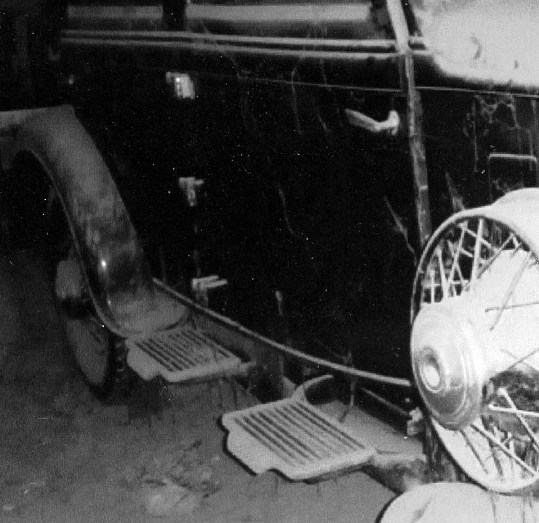
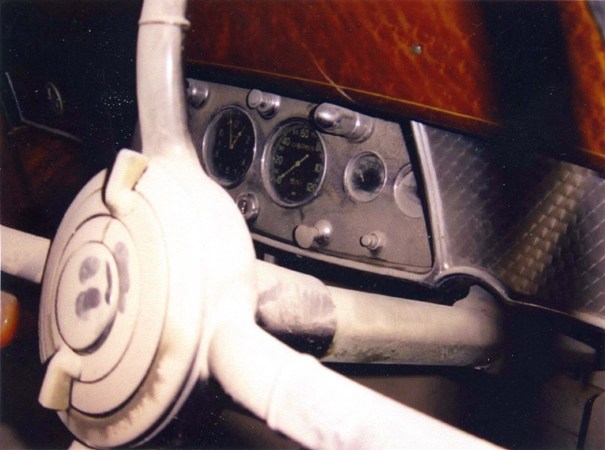
The car has survived and is located in Pakistan
[2004]
The car has only 7000 miles and has sat in dry storage
for some fifty years; it certainly will require a lot of restoration
[ These two photos: ©2004, courtesy of the owner ]
Enthusiast Nigel Davis suspects
that this is one of the two Cadillac cars that came from the Nawab's
estate but could not be sold owing to some form of lien on the vehicle; a second
Cadillac
(perhaps the Van den Plas tourer, above) is believed to have been acquired
during
the 2004 auction by Azizur Rashid Abbasi for one million Rupees (circa $25,000)
[ Photo: courtesy Nigel Davis, 2008 ]
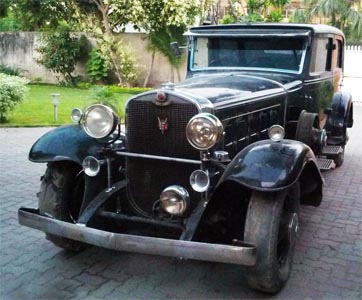
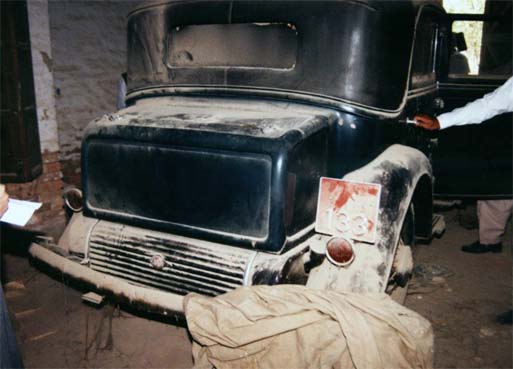
(Left) This more recent photo appeared on
"Flickr" in October, 2012
(its provenance is not known at this time)
(Right) This rear view of the car came
courtesy of Nigel Davis (Oct. 2013); again its provenance is
not known
LATE EXTRA
This You Tube video clip of the car being
started
for the first time in decades is currently (2013-13)
circulating on the Internet:
http://www.youtube.com/watch?v=fFT5y8USaFo
|
[Mystery 2] |
? |
? |
NEW, Jan. 2013:
(information from Chris Cummings) Surfacing in time for the Bonhams
Scottsdale auction later this month [Jan. 2013] is a
fascinating ambulance conversion of a 1930 V-16 Series 4375-S seven-passenger
sedan. The engine is from a Series 4361-S town sedan. The coachbuilder kept
the original wheelbase (148") but lengthened the rear quarter of the body
significantly and created a side-hung rear entrance. The fenders appear to
be customized 1930 Cadillac parts, with skirting and a streamlining effect.
The rear fenders are extended to go with the new body length. The fronts are
styled to look like 1934 Packard fenders. The stock 1930 radiator is
enclosed in a shell that looks like a 1934-1935 Cadillac V-8 or V-12 part,
but matches up nicely with a 1930 hood and allows the 1930 radiator filler
neck to protrude. The grille is very similar to (but different from) the
'34-'35 Cadillac counterpart. The engine has a second generator on the
driver's side and a voltage regulator for it on the firewall (understandable
in view of the extra lighting and siren an ambulace would carry). Somebody
did a LOT of work on this beast. License plates are 1956 California. I'm
speculating from the grey paint and the shape of the scraped-off lettering
that it may have served a naval base, perhaps during WWII. See the Bonhams
website. Late Extra:
(from Chris again) The car was sold for $44,850, including a $5,850
premium. Note: Because the chassis of this car was first used
for a Fleetwood sedan style "4375-S", I have included it also im the section
relating to those models. |
|
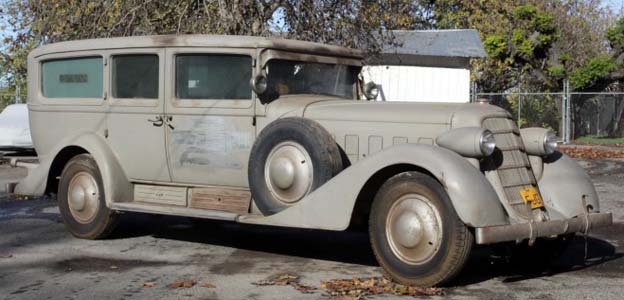
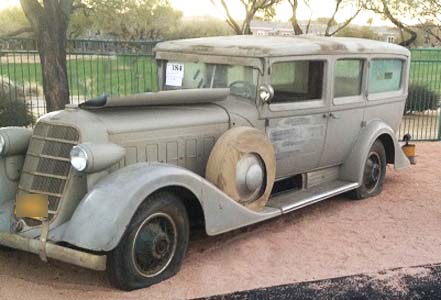
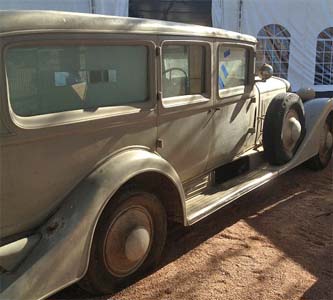
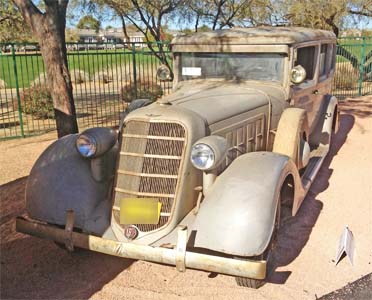
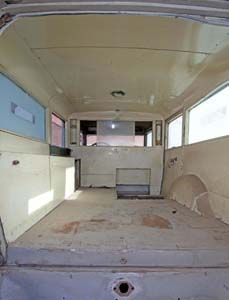
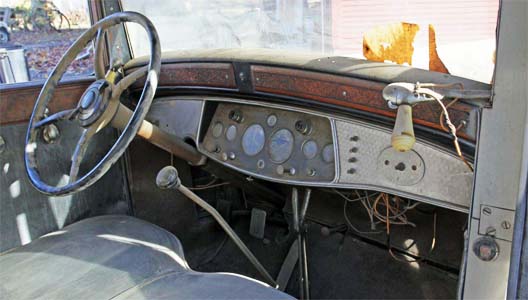
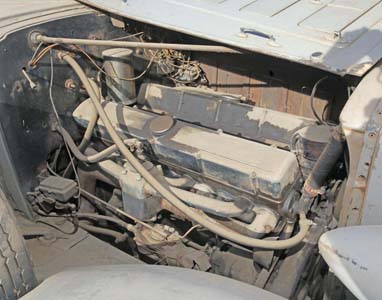
|
[Mystery 3] |
? |
? |
Listed for sale at the Kruse auction in Auburn, IN, 9/1999 [lot #1068],
was this "16 cyl. unknown exterior - Kingston custom De Luxe body. This is
a very rare limited produced car" [sic]. It was reported to have been sold
for $160,000. Anybody know more about this car? 
|
| [ex-4375] |
? |
700132 |
In 1934, this engine was put in a Chrysler Le Baron
dual-cowl phaeton by power-boat racing star, Lou Fageol. At last news (8/2005), this
unusual Cadillac-powered
car was owned by Laurence (Byron) Dorcy [art. in SS, 9/2005].
Where is it today? |
| 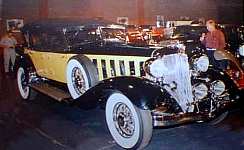
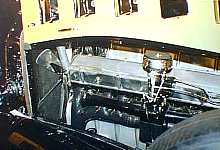 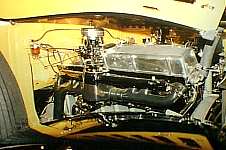
These three photos courtesy of the late Gene
Babow
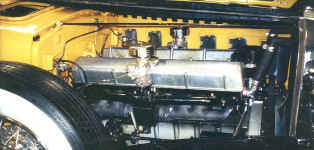 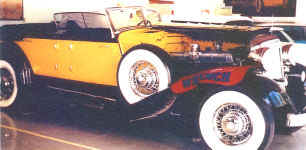
These two, from CLC Self Starter
magazine, 9/2005
|
| [ex-????] |
? |
701866 |
This most unusual
V-16 powered hot rod was brought to my attention by a dedicated V-16 owner-enthusiast,
Chris Cummings. It was built in the 40s. About that car, Chris wrote this wonderful
piece, based on information gleaned from old racing and hot rod magazines [sorry for the
condensed presentation!]:. Craig
Carash of Sandpoint, Idaho has a very special remembrance of his late uncle Bill
Carash. It is a beautifully designed and executed, hand built roadster from the
golden age, if you will, of west coast hot rodding. And it’s powered by a
Cadillac V-16 engine. In 1945, at
the age of 17, Bill Carash did what a lot of California teenagers did at that time.
He set out to build a hot rod. Only they weren’t generally known as hot rods
back then. They might be called customs, or roadsters. Or just cars.
People just went to the local used car lots or salvage yards and looked for a strong but
lightweight chassis, and maybe a light body (like a coupe or roadster). Some
builders looked to military surplus sources and used things like aircraft belly tanks to
make super streamlined vehicles. And, of course, you needed an engine. Some
worked with the four cylinder Fords. Others started with flathead Ford V-8s.
Some adventurous folks sought out the big power plants that drove the great luxury cars of
the previous generation – Marmons, Duesenbergs, Cadillacs. Bill Carash started with the engine and built the rest of the car around
it. He cruised wrecking yards until he located a junked Cadillac V-16, out of which
he bought the engine and transmission. That serial number of the engine he acquired
was 701866, which means that the donor car was shipped during June of 1930. It took him a couple of years to accomplish a thorough overhaul and reassembly,
and then he began building the rest of the car. The engine is only mildly modified
– two Stromberg 97 downdraft carburetors replace the Detroit Lubricator updraft units
it came with. And the fuel is fed by an electric pump. Again
looking to wrecking yards, Carash selected the frame, front axle and steering components
from a 1936 Plymouth. Semi-eliptics spring the front of the car with a single
transverse leaf spring in the rear. He substantially reinforced the chassis and
prepared it to accept and support the big Cadillac engine. The rear axle came from a Ford, and between that and the Cadillac transmission
Carash inserted a Columbia overdrive unit. Taking into account the gear ratios and
the rolling radius of the 7.00 x 16 tires, the theoretical top speed in overdrive was
estimated at 138 mph. A great deal of the work in constructing the car was done by
Carash himself. He had a professional shop do some of the body panels, be he bent
and welded his own bumpers (“nerf bars” in the parlance of the day). A
raked windshield offers some protection to the occupants, but this car is all about the
open air. The result of all the work was a nicely proportioned, skillfully finished
roadster, reminiscent of some of the open-wheeled Indianapolis 500 race cars of the late
‘40s and early ‘50s. The annual car show in Oakland, California was an
established event by the late 1940s. Bill Carash and some of his friends petitioned
the people in charge of the show for the chance to show their cars, and an area was set
aside for them. That Oakland Roadster Show evolved into the National Roadster Show,
and it’s now known as the Grand National Roadster Show. The Carash Custom was
shown there in 1950, and it took First Place for originality in the Street Division, and
third place in the Construction Street Division. On March
14, 1950 Mr. Wilbur Shaw, President of the Indianapolis Motor Speedway Corporation paid
Bill Carash a tremendous compliment. Mr. Shaw’s wrote as follows: "Dear
Mr. Carash, You certainly have built a very unusual and beautiful automobile and I would
like nothing better than to be able to use it for a pace car. However, we are
committed entirely to American manufacturers and there just wouldn’t ever be a
possibility of our getting it in as a pace car. Thank you very
much for your interest and a lot of good luck with it. Sincerely yours, Indianapolis Motor Speedway Corp., WILBUR SHAW, President."
If the Carash roadster had run as a
pace car at the Indianapolis 500, it would have been the only time that a Cadillac
V-16-powered automobile paced the race. The 1931 pace car was a Cadillac V-16
convertible coupe [it was actually a V-12, Chris], driven by none other than the
legendary Cadillac test driver Willard “Big Bill” Rader [another unique
Fleetwood style #4260A was one of the official cars used during the Indianapolis 500 race
in 1930; it too was driven by Bill Willard].
There would be a 1934 LaSalle pace car, but no other Cadillac product paced at the
Brickyard until a 1973 Eldorado did the honors. Bill Carash’s roadster was profiled
in the November, 1949 issue of Hot Rod magazine. In January 1951, it graced the
cover of Mechanix Illustrated, Tom McCahill’s magazine that pioneered the road
testing of new cars for readers. A detailed article including the car’s
history, its construction and descriptions of its performance on the road appeared in the
April 1955 number of Rod and Custom. The author of the Rod and Custom article was
treated to a ride in the car on a highway outside Oakland and found the experience to be
“one of the great motoring thrills of a lifetime.” He went on to say that
“the car’s center of gravity was so low and the bite of the chassis so good that
it seemed that a Grand Prix Ferrari, detuned for street use, could have no more to
offer.”1 The last time the car was licensed to drive on the road was
1956. After that the car pretty much stayed home. Mr. Carash continued to tweak the roadster and
work on it, off and on, for the rest of his life. During summer visits, his nephew
Craig would ask to see the roadster and then head immediately to the barn where it was
kept. Bill let Craig sit in the driver’s seat and would tell him about the car,
and say that he was fixing it up for him. In 1999, Bill Carash passed away, leaving no
children, only Craig and two nieces. Settling his estate turned out to be a
difficult process that took time, but ultimately Craig got the roadster that had
engendered so many happy experiences and fond memories. He quickly set about getting
the car running, replacing all of the fluids, rebuilding the fuel system and the
radiator. The first time he ever saw the car run was when he got it started.
He recounts that he has driven the car only about four miles, but he and his wife enjoyed
a short ride in it recently. “It is a hoot!” he says. The Carash
roadster is a remarkable piece of American automotive history. The hot rods of the
forties and fifties were products of the individual creativity and personality of
dedicated car guys. And unlike today, when custom cars and street rods are largely
“big ticket” items, most of the post-war roadsters were built by folks on
limited budgets who had to be creative and resourceful. As such, the cars they
created display widely varying degrees of polish and finesse. Some are clearly
homebuilt, even crude. Others, like this car, present an integrated design, neatly
executed, where everything looks like it really belongs. In
January 2009, the Carash roadster made a reprise appearance at the 60th Grand
National Roadster Show. A special section of the show entitled “Twice in
a Lifetime” featured cars that had been in the show at least once before. A few
days earlier, Craig Carash had discovered the actual plaque given to his uncle as a
participant in the 1950 show. Displayed with the car were photographs and reprints
of some of the period articles about the car. The cream and orange color scheme was
a change that Bill Carash decided to make in the late 1950s from the original flame red
paint job. Other than that, the car was very much the way it had been in 1950. Craig Carash wants to continue the process of fixing up his uncle’s pride
and joy, reinstalling a correct generator, and determining whether he needs to install a
fan (Bill Carash apparently believed that the V-16’s original fan was not needed).
Craig intends to preserve and enjoy this legacy from his uncle for years to come. |
| 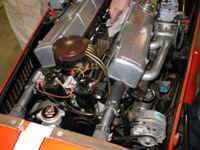
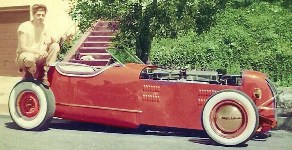
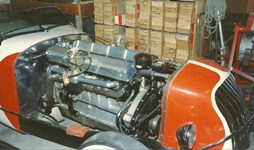 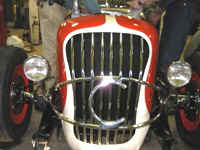
At far left, the late Bill Carash with his own
custom-built, V-16 racer
[ Photos: courtesy Chris Cummings ]
|
| [ex-4220] |
? |
701530 |
This former town
car (one of only 9 built in 1930-31) was originally shipped to Buenos Aires,
Argentina. Currently [2/2000] the motor is in Spain (near Alicante) and is powering a
custom racer (below). The owner needs a V16 distributor cap. Any ideas? |
| 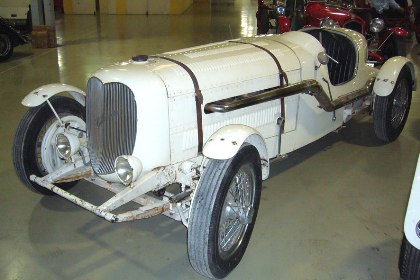  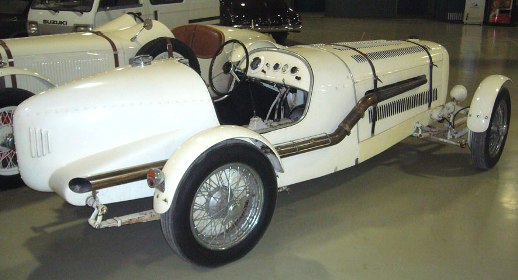
Not clearly visible in these pics
(left & center), the name Cadillac
spelled diagonally across the grille
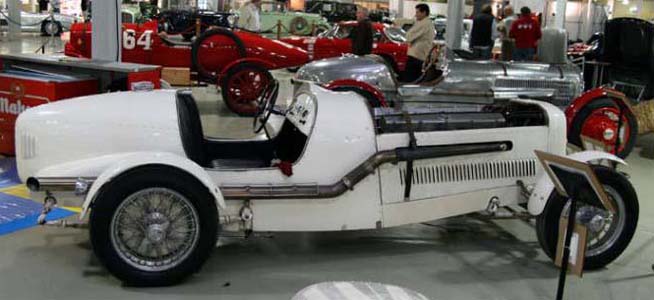
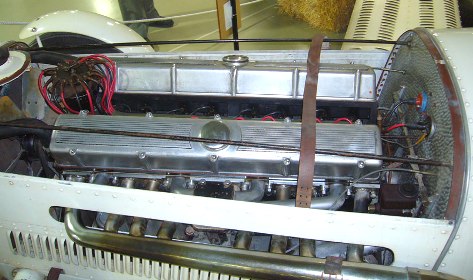
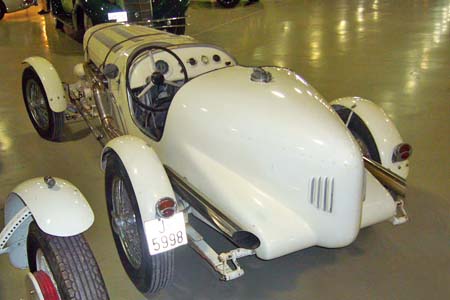 
|
| [ex-4291] |
? |
702342 |
This (British)
Alvis racing car, located in Germany, is powered by the V-16 motor removed
(ignominiously?) from a splendid 1930-31 Fleetwood-designed town car, style
4291, of which a mere 14 units were built. To me, this is tantamount to removing the
engines of the Titanic to power a Mississippi steamboat! But, hey, at least the old
dear is still serving the purpose for which it was designed, being to power an automobile.
Thanks Chris Cummings for bringing the car to my attention. Here's the information Chris
gleaned off the Internet about this "curio": Based around a
1939 Alvis Silver Crest chassis (the Coventry marque's lightest pre-WW2 design to feature
independent transverse-leaf front suspension), 'HEH 856' had already been reconfigured as
a Special by the time it entered the current ownership in 1996. Hankering after something
more exciting (not to mention VSCC eligible), the vendor commissioned Edwards Motorsport
of Warrington to fit a 1930 Cadillac V16 7.4 litre engine in place of the incumbent
(non-original) Jaguar 4.2 litre unit. Sourced from the late John Willment's estate [I
wonder if the engine was still in the original town car at the time], the American
powerplant was thoroughly overhauled prior to installation (reground / re-whitemetalled /
fully balanced crankshaft, new high compression pistons, reprofiled camshaft etc).
Breathing via eight SU carburettors and developing some 280bhp and 410lbft of torque, it
drives the back wheels via an Alvis Speed 25 four-speed all-synchromesh gearbox and 3.5:1
rear axle ratio (the latter taken from a Land Rover). Given a new tail-section by the
renowned panel beater Peter Claridge, the two-seater also boasts a hydraulic clutch,
'Brooklands' style exhaust system and hydraulic 12-inch drum brakes. Riding on 19-inch
wire wheels shod with Dunlop racing tyres (6.00-front / 7.00-rear), the self-starting 'HEH
856' has just passed a MOT test. One of many toys in the seller's collection, the
Alvis-Cadillac ran at the VSCC's SeeRed Donington Park meeting some three years ago but
has since seen little use. Intended for sprints, hillclimbs and occasional road trips, we
are informed by Simon Blakeney-Edwards of Edwards Motorsport that the Special would
benefit from an oil-cooler over longer journeys and ideally a longer steering drop arm. An
intriguing and surely unique alternative to something like a Bentley 3/8, this wonderful
Anglo-American hotrod is offered for sale with the aforementioned MOT certificate and VSCC
buff form. Chris also got this mail from the vendor in Germany: Christopher,
my car is an Alvis Special which had been used for hill climb racing in GB. I do not know
the exact date when the V16 had been transplanted but it fits in and looks and sounds
great. Actually I am working on two main issues: cooling and power generation. The cooling
is poor due to the small air inlet in the front. This was no problem during hillclimb
racing for a 2 km distance, but doesn’t work for longer trips without additional
electric fans. Therefore I would like to upgrade and restore the generator. But actually
I'm not quite sure how to disassemble the generator without causing problems with the
timing chain. Later, Chris was kind enough to give Franc the information he needed to
remove the generator; he sent him a couple of images from the slide films that Cadillac
sent the service people to illustrate that job. It was Chris also who found out the engine
number as well as the Cadillac model in which it was originally mounted. |
| 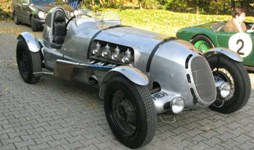 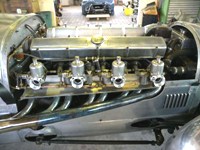
|
| [???] |
? |
? |
Here's another custom racer fitted with a Cadillac type 452-452A
engine. It was recently acquired from a collector in California by my
friend Dick Shappy of Rhode Island. I had got some pics of the car in
May, 2011 but have not found time to upload them. |
|
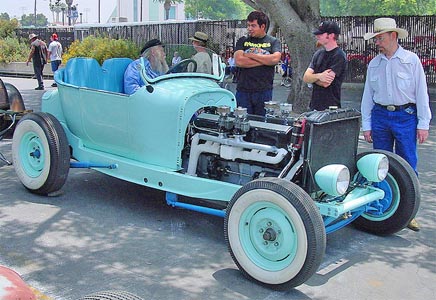
This car?
|
| [???] |
? |
? |
Here's another
custom racer apparently fitted with a Cadillac V-16 engine. Details anyone ? |
| 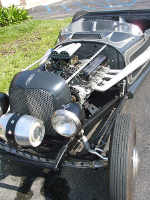
|
| [???] |
? |
? |
This red racer was
offered for sale on Ebay in late 2004; it was said to be powered by a 16-cylinder Cadillac
engine [the designer's drawing is marked "Cadillac V-16"]; apparently the car
was sold but all attempts - by myself and other enthusiasts - to get precise information
about the car and its power plant failed miserably. Perhaps the buyer might be
interested in having his car listed in the roster. |
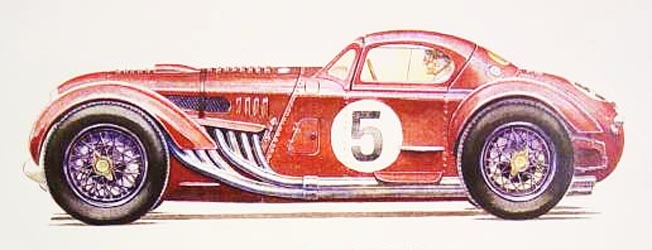
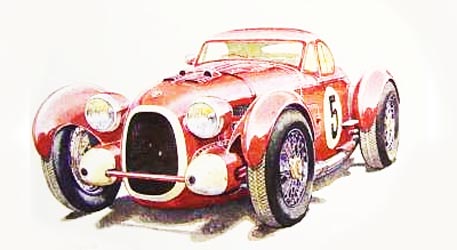


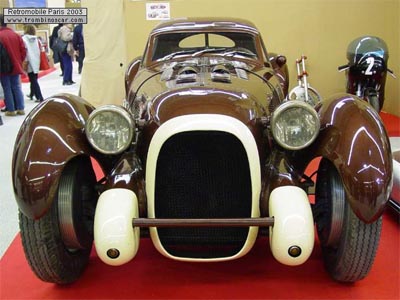
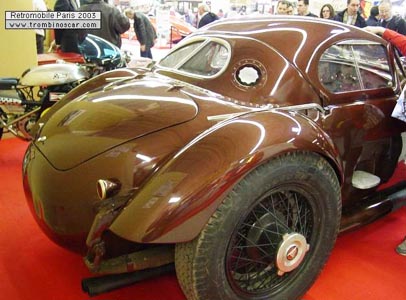
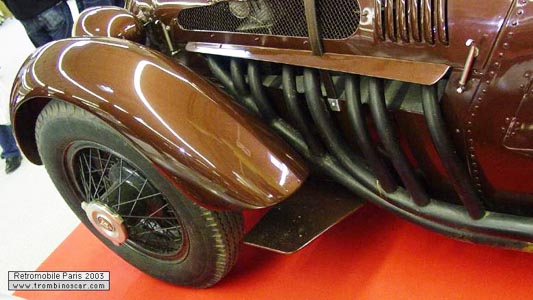
[ Photo: courtesy "Trombinoscope" ]
|
